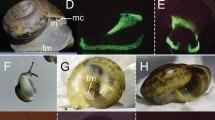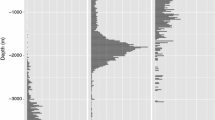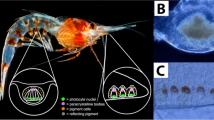Abstract
Bioluminescence is the production of visible light by a living organism. The light commonly appears as flashes from point sources (involving one or more cells, usually described as photocytes) or as a glandular secretion. A visible flash usually involves synchronous light emission from a group of cells or, if from a single-celled organism such as a dinoflagellate, from a group of organelles. The number of cells (or organelles) responding synchronously is the main determinant of the flash intensity. Bioluminescence is a common phenomenon in many deep-sea animals and is widespread among the Cnidaria. In this paper, we compare and contrast in situ and laboratory recordings of the bioluminescent responses of specimens of the deep-sea scyphozoans Atolla wyvillei, Atolla vanhoffeni, Atolla parva, Nausithoe rubra, Paraphyllina intermedia, Periphyllopsis braueri and Periphylla periphylla. Displays in all seven species consist of localised flashes and propagated waves of light in the surface epithelium. The first few single waves propagate at rates of up to 60 cm s-1 but subsequent ones in any sequence of stimuli gradually decrease in speed. After several single wave responses, a subsequent stimulus may elicit multiple waves that persist for several seconds. Following such a frenzy, the specimen becomes temporarily refractory to further stimuli, but if rested will recover its normal responses and may produce further frenzies. The dome area, situated above the coronal groove, of the genera Paraphyllina, Periphylla, and Nausithoe is covered with luminescent point sources. Such point sources are generally absent from the dome of species of Atolla. Captured specimens of A. parva also produce secretory bioluminescence, corroborating prior in situ observations of this ability. Secretory bioluminescence in P. periphylla takes the form of scintillating particles released from the lappet margins. We did not observe secretory displays in specimens of any other species in the laboratory, but one instance of apparent secretory luminescence was recorded in situ in a specimen of A. wyvillei.



















Similar content being viewed by others
References
Anctil M, Shimomura O (1984) Mechanism of photoinactivation and re-activation in the bioluminescence system of the ctenophore Mnemiopsis. Biochem J 221:269–72
Anderson PAV (1980) Epithelial conduction: its properties and functions. Progr Neurobiol 15:161–203
Anderson PAV (1985) The comparative electrobiology of gelatinous zooplankton. Bull Mar Sci 37:460–477
Arai MN (1997) A functional biology of Scyphozoa. Chapman and Hall, London
Bassot J-M, Bilbaut A, Mackie GO, Passano LM, Pavans de Ceccatty M (1978) Bioluminescence and other responses spread by epithelial conduction in the siphonophore Hippopodius. Biol Bull 155: 473–98
Buck J (1973) Bioluminescent behavior in Renilla. I. Colonial responses. Biol Bull 144:19–42
Dahlgren U (1916) The production of light by animals: Porifera and Coelenterata. J Franklin Inst 181:243–261
Flood PR, Bassot J-M, Herring PJ (1997) The microscopical structure of the bioluminescence system in the medusa Periphylla periphylla. In: Hastings JW, Kricka LJ, Stanley PE (eds) Bioluminescence and chemiluminescence: molecular reporting with photons. Wiley, Chichester, UK, pp 149–153
Haddock SHD, Case JF (1999) Bioluminescence spectra of shallow and deep-sea gelatinous zooplankton: ctenophores, medusae and siphonophores. Mar Biol 133:571–582
Haddock SHD, Rivers TJ, Robison BH (2001) Can coelenterates make coelenterazine? Dietary requirement for luciferin in cnidarian bioluminescence. Proc Natl Acad Sci USA 98:11148–11151
Herring PJ (1990) Bioluminescent responses of the deep-sea scyphozoan Atolla wyvillei. Mar Biol 106:413–417
Herring PJ (1995) Bioluminescent echinoderms: unity of function in diversity of expression? In: Emson RH, Smith AB, Campbell AC (eds) Echinoderm research 1995. Balkema, Rotterdam, pp 1–17
Herring PJ, Widder EA, Haddock SHD (1992) Correlation of bioluminescence emissions with ventral photophores in the mesopelagic squid Abralia veranyi (Cephalopoda: Enoploteuthidae). Mar Biol 112:293–298
Herring PJ, Bassot J-M, Flood PR (1997) Bioluminescent responses of the scyphozoan Periphylla periphylla from a Norwegian fjord. In: Hastings JW, Kricka LJ, Stanley PE (eds) Bioluminescence and chemiluminescence: molecular reporting with photons. Wiley, Chichester, UK, pp 154–157
Johnsen S, Balser EJ, Fisher EC, Widder EA (1999) Bioluminescence in the deep-sea cirrate octopod Stauroteuthis syrtensis Verrill (Mollusca: Cephalopoda). Biol Bull 197:26–39
Josephson RK (1974) Cnidarian neurobiology. In: Muscatine L, Lenhoff HM (eds) Coelenterate biology: reviews and new perspectives. Academic Press, New York, pp 245–78
Larson RJ, Mills CE, Harbison GR (1991) Western Atlantic midwater hydrozoan and scyphozoan medusae: in situ studies using manned submersibles. Hydrobiologia 216/217:311–317
Mackie GO (1975) Neurobiology of Stomotoca. II. Pacemakers and conduction pathways. J Neurobiol 6:357–378
Mackie GO (1976) Propagated spikes and secretion in a coelenterate glandular epithelium. J Gen Physiol 68:313–325
Mackie GO (1991) Propagation of bioluminescence in Euphysa japonica hydromedusae (Tubulariidae). Hydrobiologia 216/217:581–588
Mallefet J, De Bremaeker N (1999) Study of bioluminescence control in the medusa Periphylla periphylla. In: Roda A, Pazzagli M, Kricka LJ, Stanley PE (eds) Bioluminescence and chemiluminescence: perspectives for the 21st Century . Wiley, Chichester, UK, pp.577–580
Morin JG (1974) Coelenterate bioluminescence. In: Muscatine L, Lenhoff HM (eds) Coelenterate biology: reviews and new perspectives, Academic Press, New York, pp 397–438
Morin JG (1976) Probable functions of bioluminescence in the Pennatulacea (Cnidaria, Anthozoa). In: Mackie GO (ed) Coelenterate ecology and behavior. Plenum, New York, pp 629–638
Morin JG (1983) Coastal bioluminescence: patterns and functions. Bull Mar Sci 33:787–817
Musik K (1978) A new bioluminescent gorgonian, Lepidisis olapa, new species (Coelenterata Octocorallia), from Hawaii. Bull Mar Sci 28:735–741
Passano LM (1973) Behavioral control systems in medusae; a comparison between hydro- and scyphomedusae. Publ Seto Mar Biol Lab 20:615–645
Passano LM (1982) Scyphozoa and Cubozoa. In: Shelton GAB (ed) Electrical conduction and behaviour in “simple” invertebrates. Clarendon Press, Oxford, pp 149–202
Passano LM (1988) Variability in the initiation of diffuse nerve-net impulses in the mangrove jellyfish Cassiopea xamachana (Coelenterata:Scyphozoa). Comp Biochem Physiol 91C: 273–279
Passano KN, Passano LM (1971) The endodermal nerve net of Scyphozoa. J Morphol 133:105–123
Pugh PR (1989) Gelatinous plankton – the forgotten fauna. Progr Underwater Sci 14:67–78
Satterlie RA, Anderson PAV, Case JF (1980) Colonial coordination in anthozoans: Pennatulacea. Mar Behav Physiol 7:25–46
Shimomura O, Flood PR (1998) Luciferase of the scyphozoan medusa Periphylla periphylla. Biol Bull 196; 244–252
Shimomura O, Flood PR, Inouye S, Bryan B, Shimomura A (2001) Isolation and properties of the luciferase stored in the ovary of the scyphozoan medusa Periphylla periphylla. Biol Bull 201:339–347
Spencer AM (1974) Non-nervous conduction in invertebrates and embryos. Am Zool 14:917–929
Widder EA (2002) Bioluminescence and the pelagic visual environment. Mar Freshw Behav Physiol 35:1-26
Widder EA, Bernstein SA, Bracher DF, Case JF, Reisenbichler KR, Torres JJ, Robison BH (1989) Bioluminescence in the Monterey Submarine Canyon: image analysis of video recordings from a midwater submersible. Mar Biol 100:541–551
Widder EA, Greene CH, Youngbluth MJ (1992a) Bioluminescence of sound-scattering layers in the Gulf of Maine. J Plankton Res 14:1607–1624
Widder EA, Caimi FM, Taylor LD, Tusting RF (1992b) Design and development of an autocalibrating radiometer for deep sea biooptical studies. Oceanic Engineering Society of the IEEE, OCEANS ‘92 1:525–530
Widder EA, Johnsen S, Bernstein SA, Case JF, Neilson DJ (1999) Thin layers of bioluminescent copepods found at density discontinuities in the water column. Mar Biol 134:429–437
Wild RA, Darlington E, Herring PJ (1985) An acoustically controlled cod-end system for the recovery of deep-sea animals at in situ temperatures. Deep-Sea Res 32:1583-1589
Youngbluth MJ, Bamstedt U. (2001) Distribution, abundance, behavior and metabolism of Periphylla periphylla, a mesopelagic coronate medusa in a Norwegian fjord. In: Purcell JE, Graham WM, Dumont HJ (eds) Jellyfish blooms: ecological and societal importance. Kluwer, Dordrecht, pp 321–333
Acknowledgements
We are most grateful to Dr S.H.D. Haddock, Prof. G.O. Mackie and Prof. R. Satterlie for their constructive criticism of early drafts of this paper. P.J.H. is very grateful to Prof. P.R. Flood for the opportunity to work on Periphylla during two cruises of R/V “Håkon Mosby” and to cruise leader Prof. U. Båmstedt.
Author information
Authors and Affiliations
Corresponding author
Additional information
Communicated by J. P. Thorpe, Port Erin
Rights and permissions
About this article
Cite this article
Herring, P.J., Widder, E.A. Bioluminescence of deep-sea coronate medusae (Cnidaria: Scyphozoa). Marine Biology 146, 39–51 (2004). https://doi.org/10.1007/s00227-004-1430-7
Received:
Accepted:
Published:
Issue Date:
DOI: https://doi.org/10.1007/s00227-004-1430-7




